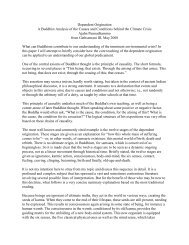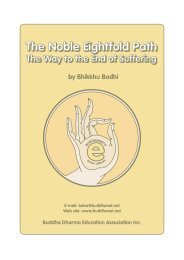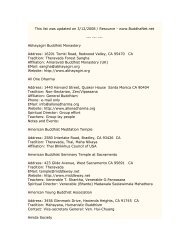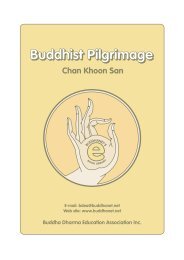FEARLEss MOUNTAIN - Urban Dharma
FEARLEss MOUNTAIN - Urban Dharma
FEARLEss MOUNTAIN - Urban Dharma
You also want an ePaper? Increase the reach of your titles
YUMPU automatically turns print PDFs into web optimized ePapers that Google loves.
He became seriously ill and had a major breakthrough in his<br />
practice and finally “realized what a silly person I was and made<br />
up my mind to go back and surrender to Ajahn Chah.”<br />
Ajahn Chah must have been very fond of his first farang disciple<br />
(especially as he was much more mature and durable than<br />
many of us who followed), which meant he didn’t make life easy<br />
for him and afterwards loved to tell stories about him and occasionally<br />
jab in the needle. As often happened, things reported<br />
to Luang Por got magnified and embellished and recounted over<br />
and over.<br />
One episode involved eating som tum, the raw papaya salad<br />
that’s made fiery spicy in the northeast. Ajahn Sumedho was<br />
caught by surprise the first time he ate it, with comical results,<br />
and the story grew to him picking up handfuls of it, stuffing it<br />
in his mouth and catching on fire from it. Luang Por used to do<br />
an imitation that included Ajahn Sumedho smearing som tum<br />
on his face.<br />
Then on one of the Buddhist holy days, when Ajahn Sumedho<br />
had gone to see Luang Por at his kuti, Luang Por told him to<br />
go prepare for circumambulation, wien tien in Thai. The way<br />
Luang Por told it, Ajahn Sumedho showed up with his bowl all<br />
packed and ready to travel, because he thought they were going<br />
to Vientiane (the capital of Laos).<br />
Ajahn Sumedho says that he was generally respected by the<br />
monks because he practiced hard, but to the laypeople he became<br />
something of a circus attraction, “like a monkey.” All they knew<br />
of America in those days was from Elvis Presley movies and<br />
they wondered why an American would want to come live in an<br />
austere forest monastery when he could be home “riding a big<br />
motorcycle and singing and dancing in the street.”<br />
A senior scholar monk in the area was once visiting<br />
Ajahn Chah. Ajahn Sumedho came to Ajahn Chah’s kuti while<br />
they were talking. Astonished, the<br />
We were told that Ajahn Sumedho<br />
was sick with malaria . . . we asked how<br />
he was, and with a huge grin he said,<br />
“Not very well.” That was impressive.<br />
scholar asked, “Can a farang be<br />
a monk” to which Ajahn Chah<br />
replied, “He’s a better monk than<br />
you—he doesn’t handle money!”<br />
I first heard of him in<br />
late 1970. I had been ordained<br />
for about two months in Wat<br />
Boworn in Bangkok, which was pretty much Dhammayut 4<br />
headquarters. I had met several veteran Pra Farang, and though<br />
they were friendly, dedicated and seemingly very clear about<br />
what they were doing, there was something subdued, almost<br />
desperate, about them all—maybe just their Britishness giving<br />
off that feeling of likeable, duty-bound people slogging onward.<br />
Then Jack Kornfield (Santidhammo Bhikkhu) and Douglas<br />
Burns (Suvijjano Bhikkhu) showed up after spending a Vassa<br />
(their first) with Ajahn Chah and Sumedho. They were practically<br />
bursting with enthusiasm and it was contagious, as much as<br />
anything could be for me in my depressed state of those days.<br />
Ajahn Chah showed up in Bangkok not long afterwards and<br />
blew me away. A few weeks later I was on the train to Ubon.<br />
When I arrived at Wat Pah Pong, monks were just getting<br />
back from pindapat. I saw Suvijjano and one other farang,<br />
Dhammaguto, and then Ajahn Sumedho was there and they<br />
introduced me. He had his famous ear-to-ear grin—sort of<br />
unmonk-like, I thought, having been around dour types like<br />
Khantipālo in Bangkok—and welcomed me.<br />
I stayed for about three weeks. He was generous with his<br />
time, taking us to see Ajahn Chah on a few occasions and<br />
inviting us to his kuti for tea and conversation. There was<br />
something very natural and unforced about his bhikkhu-hood.<br />
He would admit that food could be delicious, that things could<br />
be attractive—also seemingly unmonk-like—but he had the<br />
wider view that such things were bound up with their opposites.<br />
Rather than fostering blind revulsion and avoidance, he talked<br />
about learning how the mind works in all situations in order to<br />
no longer be a slave to habits. He would say, “It’s natural to like<br />
sweet things. You give your girlfriend chocolates—you don’t give<br />
her samor (empyric mirobalan, small sour fruit that is taken as a<br />
laxative and is a standard post-noon refreshment for monks in<br />
northeast Thailand) pickled in Ajahn Chah’s urine.” He obviously<br />
had great trust in Ajahn Chah and confidence in monastic<br />
life. Being there and experiencing his presence and common<br />
sense and of course Ajahn Chah’s was very uplifting for me. I<br />
decided that after getting my visa renewed in Bangkok, I would<br />
return.<br />
A couple of months later I was back, as hot season was<br />
about to begin. Ajahn Sumedho was at Wat Tam Saeng Pet 5<br />
and Luang Por was sending farangs there to stay with him, so<br />
Dhammagutto and I, who had<br />
returned together, were on our<br />
way after a few days.<br />
We were told that<br />
Ajahn Sumedho was sick with<br />
malaria, a recurrent illness for<br />
him. Someone led us to his cave<br />
on the hillside. He was sitting<br />
crosslegged, wrapped in his robe. He greeted us, we asked how<br />
he was, and with a huge grin he said, “Not very well.” That was<br />
impressive. He didn’t look like he was suffering just because he<br />
was very ill.<br />
As the mind is wont to, I had already started to accustom myself<br />
to Wat Pah Pong and feel some sense of security in the routine<br />
there. All of a sudden I was in a huge, mostly empty monastery,<br />
consigned to a cave and left to practice on my own. The first night’s<br />
jolly meeting in the sālā 6 , with a full kettle of some steaming sweet<br />
4. Dhammayut: Refers to one of the two main orders of<br />
Theravāda Buddhism in Thailand, the other being the Mahānikai.<br />
• Fearless Mountain<br />
5. Wat Tam Saeng Pet: A branch monastery near<br />
Wat Pah Pong located on a small hill with caves.<br />
6. Sālā: Meeting hall.


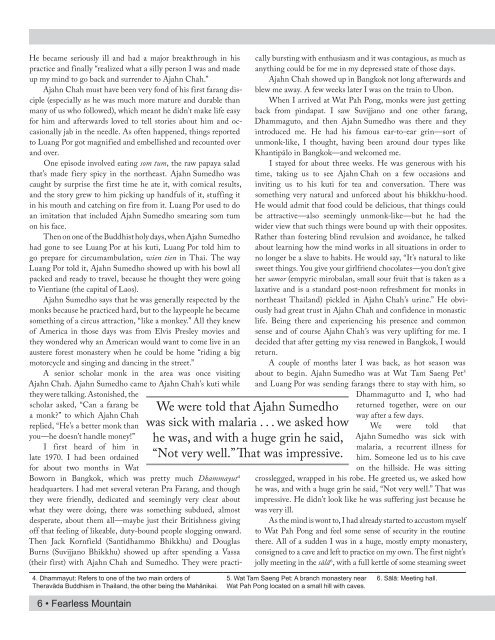
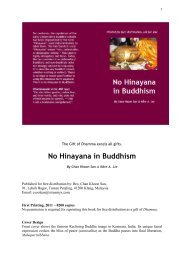

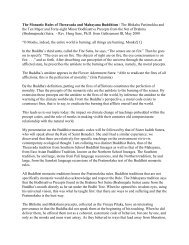
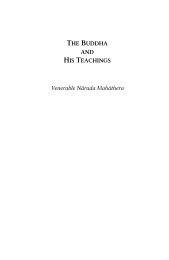


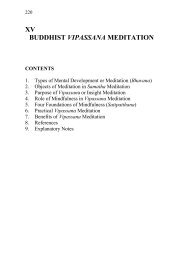

![Path of Freedom [Vimuttimagga] - Urban Dharma](https://img.yumpu.com/34050512/1/177x260/path-of-freedom-vimuttimagga-urban-dharma.jpg?quality=85)
